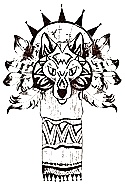DEITIES, CULTURE HEROES AND ANCESTORS.
IMAGES AND THE BODY.
INITIATION RITES.
NATURE SPIRITS, HUNTING RITUALS, AND VEGETATION RITES.
THE SOUL, THE DEAD AND ANCESTORS.

ENCYCLOPEDIA OF RELIGION
LINDSAY JONES. Macmillan Reference USA
Since the Indians of South America do not conform culturally, there is no religious uniformity among them. Despite this inconsistency, an acceptable overview can be achieved by subdividing the continent’s large, geographically distinct regions into the following cultural areas.
1. The Andes. This mountain range stretches from present-day Colombia to Chile. The highland regions of Peru, lying between the Pacific coast region and the valleys that cut through the mountain range, were taken over in the distant past by highly advanced agrarian cultures. Among the most significant of these cultures was the Inca empire, which extended into the dawn of historical times. Direct descendants of earlier Andean cultures, the Quechua and Aymara peoples inhabit present-day Peru and Bolivia.
2. Amazon and Orinoco rivers. These jungle- and savanna-covered regions were conquered by tropical farming cultures. From the standpoint of cultural history, this area also includes the mountainous sections of present-day Guyana; in early historical periods, the Amazon cultural area eventually spread to the Atlantic coast. As in the past, it is now inhabited by tribes belonging to a number of linguistic families, both small and large (Tupi, Carib, Arawak, Tucano, and Pano), and by a number of linguistically isolated tribes. Together they form cultural subareas that display religious specializations.
3. Mountains of eastern Brazil. This region is occupied by groups of the Ge linguistic family, who practice rudimentary farming methods; they settled in these hinterlands of the Atlantic coast region, joining indigenous hunting tribes. A few of these Ge groups have survived culturally up to the present time.
4. The Gran Chaco. The bush and grass steppes of this area stretch from the Paraguay River west to the foothills of the Andes. The area was initially divided among hunters, fishers, and gatherers, and these cultures came under diverse influences from neighboring agriculturists. A series of more or less acculturated groups of the Guiacurú linguistic family (the Mataco and the Mascoy) may still be encountered at the present time.
5. The Pampas and Patagonia. Hunting groups wandered through these flatlands of the southern regions of South America. The extinct Pampa and Tehuelche Indians were among the peoples of this region. The Tierra del Fuego archipelago, near the Strait of Magellan, is also included within this territory. Although the inhabitants of these regions—the Selk’nam (Ona), Yahgan, and Alacaluf—are considered extinct, their culture and religion were well documented before they vanished.
6. Southern Andes. This area, especially its middle and southernmost regions, is populated by the agrarian Araucanians of Chile, who have prospered up to the present time. Their success has been attributed to their development of a self-sufficient culture a few decades before the Spanish invasion in the early sixteenth century. This development was the result of the influence of highly advanced Peruvian cultures, as the Inca empire progressed to the Maule River in Chile. In the eighteenth and nineteenth centuries, the Araucanians expanded eastward, but this part of the group, like its predecessors in the area, eventually became extinct. Pronounced differences in religious phenomena appear within each of these cultural areas; these phenomena present certain discrepancies when seen together. The most outstanding contrast appears between the highly developed Andean religions, which are founded on priesthood and ruling cults, and the religious beliefs of the tribes in the eastern lowlands. Some typical examples of their forms and their respective beliefs should help to clarify their differences.
SEE ALSO
Amazonian Quechua Religions; Ethnoastronomy; Ge Mythology; Inca Religion; Inti; Jaguars; Lord of the Animals; Mapuche Religion; Selk’nam Religion; Shamanism, article on South American Shamanism; South American Indians, articles on Indians of the Andes in the Pre-Inca Period and Indians of the Gran Chaco; Supreme Beings; Tehuelche Religion; Viracocha; Yurupary.
OTTO ZERRIES (1987) Translated from German by John Maressa
















